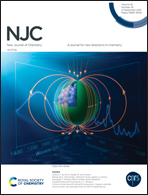Design of novel photosensitizers and controlled singlet oxygen generation for photodynamic therapy†
Abstract
Photodynamic therapy (PDT) is a promising strategy in cancer treatment with its relatively lower side effect profile. Undoubtedly, the key component of PDT is the photosensitizers with a high ability to produce singlet oxygen. In this work, iodinated or brominated boron dipyrromethene-bearing trimers (5 and 6) were prepared as photosensitizers and their molecular structures were characterized by mass spectrometry and NMR (1H and 13C) spectroscopy. Their photophysical and photochemical abilities were also evaluated in detail. The molar absorption coefficient (ε) of compound 5 was found to be 2.5 times higher than that of compound 6. The photosensitizer (5), bearing iodinated BODIPY units, exhibited almost a non-fluorescent profile with a fluorescence lifetime of 0.12 ns, whereas the other photosensitizer (6) exhibited a more moderate fluorescence character with a fluorescence lifetime of 1.22 ns. The singlet oxygen quantum yields of the photosensitizers were determined to be 0.88 and 0.76, respectively, by the chemical trapping method. Moreover, the biological assessment of the novel compounds showed that these PSs were internalized into the cells and triggered cell death in a light source-dependent manner, underlying the success of the compounds in PDT in vitro.



 Please wait while we load your content...
Please wait while we load your content...